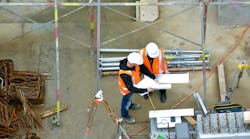International Powered Access Federation (IPAF) has published a U.S. edition of guidance aimed at avoiding trapping or crushing incidents when aerial work platforms (AWPs) are used in confined overhead spaces. The Best Practice Guidance for AWPs: Avoiding Trapping/Crushing Injuries to People in the Platform is available in the Publications section of the IPAF website and at www.awpt.org.
When used safely, AWPs make work at height more efficient and effective than using traditional methods of access. They significantly reduce the risk of injuries through falling from height. Unfortunately, there have been a number of fatal accidents involving the use of AWPs in which the operator was crushed against fixtures or other obstacles while working at height. IPAF believes that such incidents can be prevented by correct planning, preparation and selection of appropriate machinery to be used correctly.
This guidance was originally produced by a group of British organizations collectively known as the Strategic Forum for Construction, which included IPAF and the HSE (the U.K. Health and Safety Executive). It was prepared by the industry to provide clarity about the safe use of AWPs including planning, equipment selection, training, provision of information, familiarization, safe use, supervision and rehearsal of rescue procedures, together with monitoring of the whole process.
The U.K. document has been on the IPAF and AWPT websites for some time. The document has now been reviewed and made available for American use, in response to requests from AWPT training centers and IPAF members, including the IPAF Manufacturers’ Technical Committee. There are no substantive changes to the document, and any changes are limited to items that are related to legislation, standards, or language.
“This document aims to focus thinking, and actions, with regard to the avoidance of ‘crushing’ accidents on AWPs,” says Kevin O’Shea, chairman of the IPAF North American Regional Council. “It helps to focus collective industry thinking on a strategic preventative approach."


